What Is Team Dynamics a Guide to High Performance
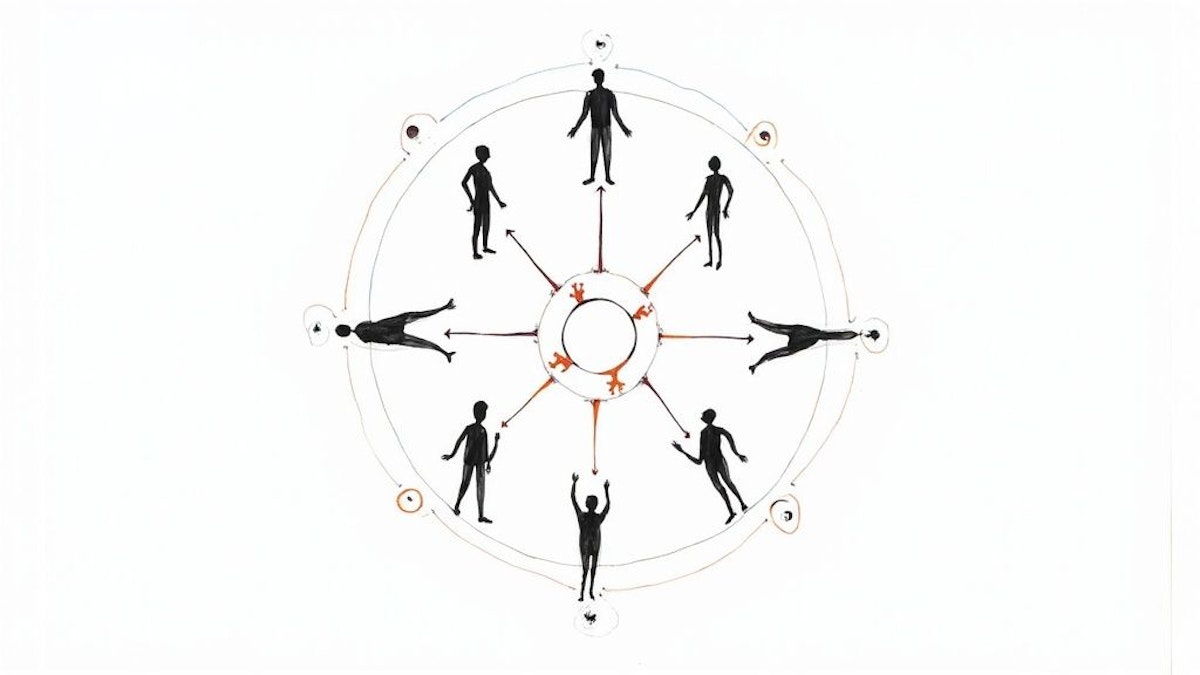
Team dynamics are the unseen psychological forces that shape how your team members talk to each other, work together, and ultimately, achieve their goals. It’s the chemistry that decides if a group of smart people becomes a high-performing unit or just a collection of individuals working in the same room.
The Invisible Force Driving Your Team's Success
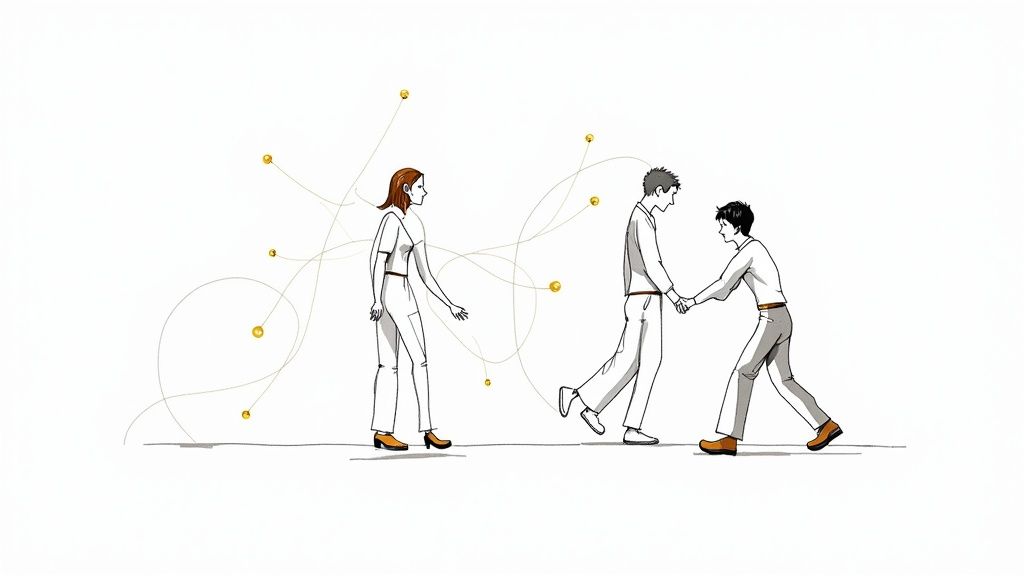
Stop thinking of team dynamics as another piece of corporate jargon. Instead, picture it as the invisible engine running your team. Think about a championship sports team—their wins don't just come from raw talent. They come from how the players anticipate each other's moves, communicate with a glance, and cover for one another seamlessly. That's what great team dynamics look like in action.
This complex web of interactions is what makes or breaks a team. It’s the difference between a group that challenges ideas and innovates, and one that gets bogged down in personal arguments. Learning to see and guide these dynamics is one of the most powerful things a leader can do to drive performance and keep morale high.
Why Team Dynamics Matter for Business Results
The impact of good team dynamics goes way beyond just having a pleasant workplace; it hits the bottom line. These interactions are the bedrock of a team's behavior, its rapport, and its output. It's about more than just hiring talented people and hoping for the best.
The numbers back this up. A Zippia study reports that 75% of employees believe teamwork and collaboration are absolutely vital for business success.
Even more telling, a Salesforce study found that 86% of executives point to poor collaboration as a primary cause of workplace failures. These stats aren't just numbers; they're a clear warning that ignoring how your team works together is a massive business risk. It’s clear that understanding these interpersonal forces isn’t a soft skill—it’s a core part of building a resilient, competitive organization. The evidence is overwhelming that a well-functioning team is a key to success, showing just how much collective effort influences outcomes.
The Building Blocks of a Cohesive Team
So, what exactly goes into creating these powerful dynamics? It all boils down to a few core elements that either build momentum or create friction within a team.
To put it simply, healthy team dynamics rest on a few key pillars. Think of these as the foundational elements that every strong team needs to build upon.
| Key Pillars of Effective Team Dynamics | |
|---|---|
| Pillar | Description |
| Communication Patterns | How information moves. Is it open and transparent, or does it get stuck in silos? |
| Psychological Safety | Do people feel safe to speak up, ask questions, or admit mistakes without fear of being shamed? |
| Trust and Respect | The bedrock of collaboration. Team members rely on each other and value everyone's input. |
| Shared Goals and Accountability | A clear, unified purpose where everyone owns their part in both the wins and the losses. |
When these components are in place and working well, they create a virtuous cycle. Positive interactions lead to more trust, which encourages better communication, driving your team toward innovation, resilience, and incredible results.
The Core Components Shaping Team Interactions
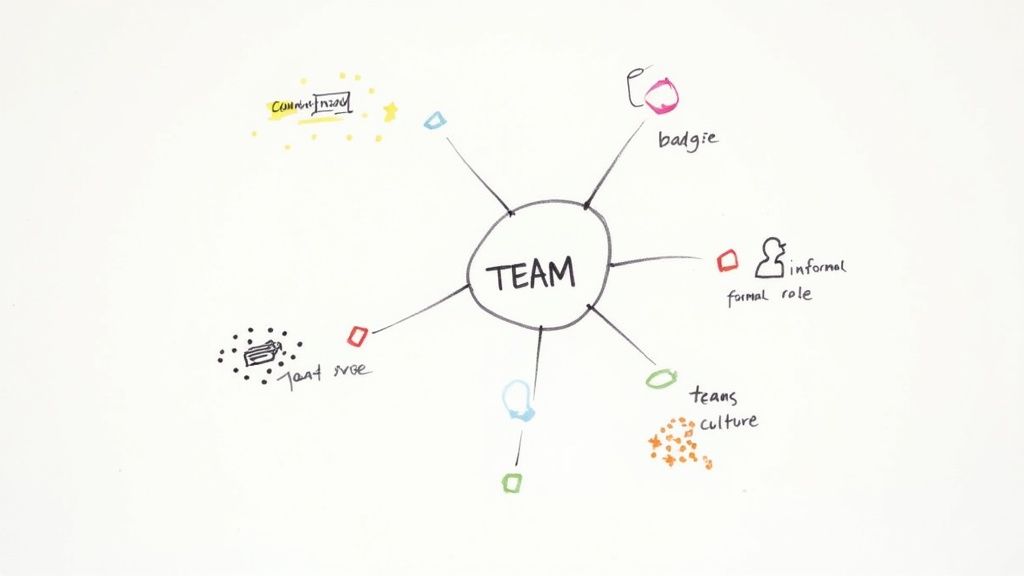
To really get what makes a team tick, you have to look under the hood. Think of it like a band. You can have the most talented guitarist and a powerhouse drummer, but if they can't find a rhythm together, you just get noise, not music. The final sound depends entirely on how they listen to each other and blend their individual parts into a cohesive whole.
Every team works the same way. It's a mix of distinct forces that dictate how the group functions, for better or worse. Understanding these fundamental building blocks is the only way to spot problems and start building a better, more collaborative environment.
Formal and Informal Roles
On paper, everyone has a job to do. You have the engineer, the marketer, and the project manager. These formal roles are essential—they create structure and make it clear who owns what. Without them, you’d have chaos, with people stepping on each other's toes or critical tasks falling through the cracks.
But that’s only half the story. As soon as people start working together, a whole other set of informal roles bubble up to the surface. These roles aren't assigned; they emerge based on personality and natural instincts, and they have a huge impact on how the team feels and performs.
You’ve probably seen them in action:
- The Mediator: The person who always seems to calm things down when a debate gets heated.
- The Challenger: The one who isn’t afraid to ask "But why?" and stops the team from coasting into groupthink.
- The Silent Disruptor: This person won’t argue openly, but their resistance shows up in missed deadlines or passive comments that drag the team down.
- The Organizer: The teammate who just naturally keeps track of deadlines and action items, keeping everyone else on track.
Ignoring these informal roles is a mistake. A team full of challengers with no mediators might burn out from constant conflict, while a team without a natural organizer could easily get lost in the weeds. These hidden dynamics are always at play.
Communication Styles and Norms
Communication is the absolute lifeblood of any team, but it’s rarely a simple, one-size-fits-all process. A person who is direct and to the point can come across as abrasive to a teammate who prefers a more collaborative, relationship-first approach.
When there are no ground rules, these style differences can easily lead to misunderstandings and resentment. It’s no wonder that a survey by Fierce, Inc. found 97% of employees and employers agree that a lack of alignment within a team impacts the outcome of a task or project. That alignment starts with how we talk to each other.
Strong teams don't just let communication happen. They are intentional about it. They decide how they will interact, setting clear norms for everything from urgent pings to giving feedback that helps instead of hurts.
This isn't about micromanaging conversations. It's about preventing small friction points from turning into major roadblocks, ensuring information flows smoothly. This is also how you start building the other characteristics of effective teams, like trust and a shared sense of purpose.
Team Size and Composition
Ever notice how a small team of three can make a decision in minutes, while a team of twelve takes all day? That’s team dynamics in action. The number of people in a group dramatically changes how it operates.
Smaller teams, usually three to seven members, tend to communicate more freely and build trust faster. With fewer moving parts, it's simply easier to stay agile and coordinated.
As a team gets bigger, the complexity skyrockets. Communication can fracture into cliques, and the risk of "social loafing"—where some people coast because they feel less accountable—goes way up. It becomes a real challenge to keep everyone pulling in the same direction.
The mix of people on the team is just as crucial. A diverse group with different skills and perspectives is your best bet for tackling tough problems and sparking innovation. But that same diversity means you have to work harder to bridge communication gaps and make sure every voice is heard—a true test of a leader's ability to manage team dynamics well.
How Leaders Architect Team Environments
Great leaders do more than just manage workflows and hit deadlines. They are the architects of their team’s environment, intentionally designing the culture, a day at a time, through their actions and behaviors. They understand that strong team dynamics aren't an accident; they are the direct result of a well-designed space where people can thrive.
This role as an architect is even more crucial in today’s hybrid and remote workplaces. Without the casual connections of a physical office, a leader's intentionality is what holds a team together, driving engagement, fresh ideas, and real business results.
Cultivating Psychological Safety
The foundation of any high-performing team is psychological safety. It’s that feeling everyone shares that it’s okay to take risks. It means you can admit a mistake, ask a "dumb" question, or challenge a popular idea without fear of being shut down or humiliated.
A leader builds this safety not with grand speeches, but through consistent, small actions. They set the tone by admitting their own mistakes, reacting to failure with curiosity instead of blame, and making a point to ask the quieter members of the team for their thoughts. This creates an environment where people feel safe enough to be creative and solve tough problems together.
The Power of Coaching Over Commanding
Another key blueprint for a strong team is for a leader to act more like a coach than a commander. Micromanagement is a classic leadership mistake that destroys trust and independence. It makes people feel like cogs in a machine, not valued partners in the work.
Instead of dictating every move, a coaching-focused leader asks insightful questions, gives feedback that helps people grow, and connects daily tasks to the company's larger mission. This shift empowers the team, creating a deep sense of ownership and accountability. While different leadership personality types might find this more or less natural, any leader can learn to be a better coach.
This isn't just about being nice; it's a direct line to better performance. Gallup’s research across thousands of global teams found that managers account for a staggering 70% of the variance in employee engagement.
The proof is in the numbers: teams in the top quartile of engagement are not just happier—they are also 23% more profitable. This shows a direct financial link between a leader’s ability to create an engaging environment and the company's bottom line. You can dive deeper into the science behind high-performing teams from Gallup.
Granting Autonomy and Empowering Members
Finally, great architects know when to step back and give their team autonomy. Empowering people means trusting them to make decisions about their own work. It's about setting clear goals and boundaries, then giving them the freedom to figure out how to get there.
This approach builds both confidence and skill. When people feel trusted, they’re far more likely to take initiative, try out new approaches, and give that extra discretionary effort that makes all the difference.
On the flip side, certain leadership habits can crush autonomy:
- Excessive Reporting: Demanding constant, minor updates signals a deep lack of trust.
- Overriding Decisions: Regularly reversing a team member's choices sends the message that their judgment isn't valued.
- Controlling Information: Withholding important context the team needs to make good decisions on their own.
By steering clear of these traps and focusing on psychological safety, coaching, and autonomy, a leader can do more than just manage a group of individuals. They can build a resilient, innovative, and successful team from the ground up.
Recognizing The Signs Of Healthy And Unhealthy Dynamics
So, how can you tell if your team's chemistry is an asset or a liability? Think of it like a seasoned mechanic listening to an engine. With a trained ear, they can tell if it's purring along perfectly or about to break down. A skilled leader can do the same by observing the team's everyday behaviors. These signals are always there—you just need to know what you’re looking for.
Positive dynamics aren't about everyone agreeing all the time. Far from it. In fact, the healthiest teams thrive on passionate, respectful debate that sharpens ideas and pushes everyone forward. You’ll see a real sense of shared accountability, where wins are celebrated together and slip-ups are treated as chances to learn, not opportunities to point fingers.
On the flip side, unhealthy dynamics often fester right under the surface. They show up as a nagging blame culture, where the first response to a problem is "who did this?" instead of "how do we fix this?" You might notice a lot of gossip, passive-aggressive comments in meetings, or a general hesitance to have the tough conversations that are actually necessary for growth. These are the red flags that trust is breaking down.
Hallmarks Of A Thriving Team
A healthy team just feels aligned. There's a current of mutual respect running through every interaction. This doesn't happen by magic; it's built on a solid foundation of trust and clear communication. In this environment, everyone feels safe enough to contribute their best work without fearing unfair judgment.
Here are a few key signs of a team that's firing on all cylinders:
- Constructive Conflict: Team members challenge ideas, not each other. Disagreements are viewed as a necessary part of the journey to find the best solution, and they're always handled with respect.
- Shared Ownership: When a project is a hit, it's a team win. When it misses the mark, the group rallies to figure out what went wrong, focusing on the process, not on finding a scapegoat.
- Open and Honest Communication: Information isn’t hoarded. People are comfortable saying, "I don't know," asking for help when they need it, and giving each other feedback that’s meant to help, not hinder.
This infographic does a great job of showing how leaders can create the right conditions—safety, coaching, and autonomy—for these positive dynamics to take root.
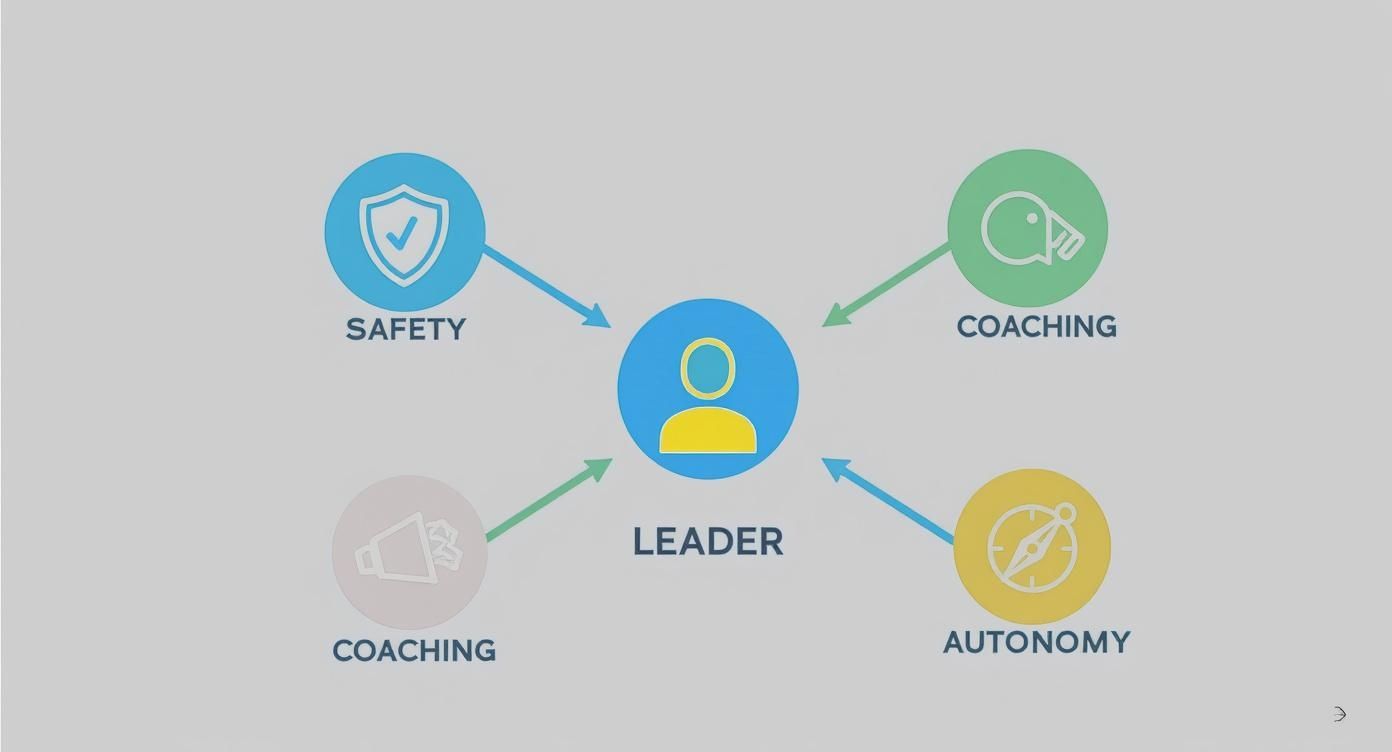
As you can see, a leader's role isn't to micromanage tasks but to build a supportive structure that empowers the team to work with confidence and independence.
Warning Signs Of Toxic Dynamics
Negative dynamics can start small, but they are incredibly corrosive over time. They suck the energy out of a room, crush motivation, and are a massive driver of employee turnover. Based on the same Fierce, Inc. study, it's no wonder that a staggering 97% of workers say a lack of team alignment harms project outcomes.
Keep an eye out for these tell-tale signs of trouble:
- Conflict Avoidance: This is the toxic cousin of constructive debate. Here, crucial issues are swept under the rug because nobody wants to deal with the awkwardness. This just lets problems fester and resentment build.
- Cliques and Gossip: You’ll notice factions forming and important conversations happening in whispers or private messages instead of in the open. This breeds an "us vs. them" mindset and shatters trust.
- Unequal Participation: In meetings, do one or two people do all the talking while everyone else stays silent? This is a huge sign that not everyone feels their voice is welcome or valued.
Once these negative patterns set in, they can be tough to reverse. Turning things around often requires dedicated workplace conflict resolution strategies to mend broken trust and get communication back on track.
A team's dynamic is like its immune system. When it's strong, it can fight off challenges and recover quickly from setbacks. When it's weak, even minor issues can escalate into chronic problems that hinder performance.
Positive vs. Negative Team Dynamics
Sometimes the easiest way to grasp the difference is to see it laid out side-by-side. The following table contrasts how the same workplace situations can unfold in dramatically different ways, all depending on the health of the team’s dynamics.
| Indicator | Signs of Positive Dynamics | Signs of Negative Dynamics |
|---|---|---|
| Meetings | Energetic discussions with diverse input; clear action items. | Dominated by a few voices; low energy and disengagement. |
| Feedback | Given and received openly as a tool for growth. | Avoided entirely or delivered defensively and personally. |
| Problem-Solving | Collaborative effort to find the best solution. | Focus on assigning blame rather than fixing the issue. |
| Accountability | Team members hold each other to high standards supportively. | Individuals deflect responsibility; deadlines are missed. |
As the comparison makes clear, the divide between positive and negative dynamics is stark. It’s the difference between a team that propels the organization forward and one that holds it back.
Actionable Strategies to Improve Your Team's Dynamics
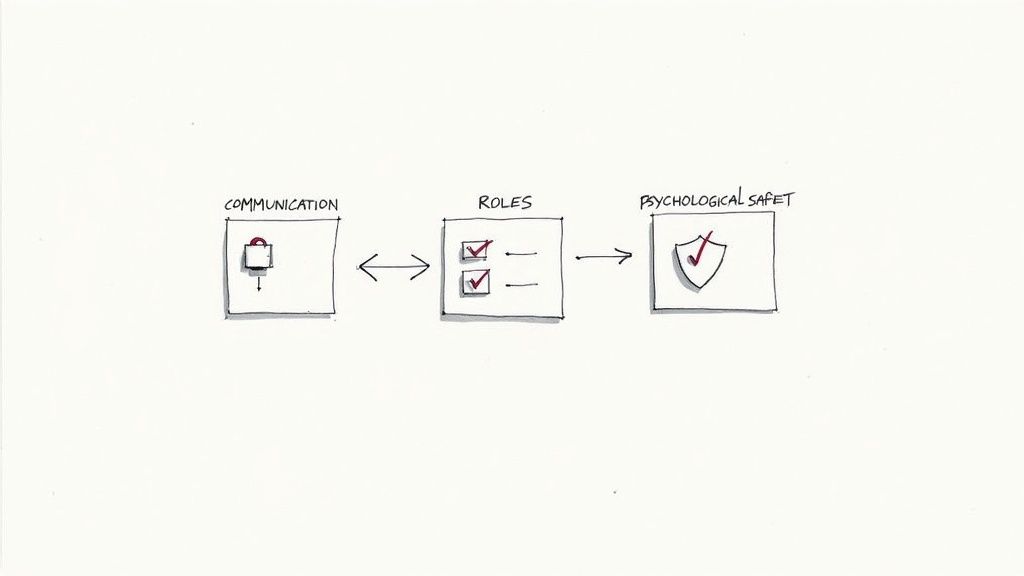
Spotting issues in your team's dynamics is one thing, but fixing them requires deliberate action. Moving from diagnosis to improvement isn't about guesswork; it's about having a practical playbook of strategies you can put into motion right away.
By focusing on the fundamentals—like communication, role clarity, and a shared sense of purpose—you can start making tangible improvements. These methods provide a clear roadmap for building a more resilient, cohesive, and effective team from the ground up.
Establish Clear Communication Protocols
Nothing creates friction faster than ambiguity. When people have different ideas about how, when, and where to share information, you end up with missed deadlines, repeated work, and a whole lot of frustration. That's why clear communication protocols are non-negotiable for smooth collaboration.
This means getting specific about which channel to use for what. For instance, urgent issues get a ping in a dedicated chat channel, formal decisions are confirmed over email, and project updates live in your project management tool. A huge part of this is understanding how to improve team communication for better results.
Laying down these ground rules eliminates confusion and ensures everyone knows exactly where to find the information they need, when they need it. It’s a simple change that pays huge dividends in efficiency.
Define Roles and Responsibilities with a Framework
"I thought you were handling that." If you've ever heard that phrase, you've witnessed a breakdown in role clarity. When responsibilities are fuzzy, tasks fall through the cracks, and team members can feel either buried in work or completely left out.
A simple framework can solve this overnight. One of the most effective tools for this is the RACI matrix, which clarifies who is:
- Responsible: The person actually doing the work.
- Accountable: The one person who ultimately owns the outcome.
- Consulted: Experts or stakeholders who need to provide input.
- Informed: People who just need to be kept in the loop.
Using a RACI chart for major projects clears up any "who does what" confusion and fosters a real sense of accountability. It empowers people by making their specific contributions crystal clear.
A critical part of understanding what is team dynamics is recognizing that contribution isn't always equal. While clarity is key, high performance doesn't always mean perfectly balanced workloads.
Interestingly, perfect balance might not even be the goal. A 2013 study published in the Journal of Computer-Mediated Communication analyzing thousands of online team projects found that a small core of members often does most of the heavy lifting. The surprising part? This imbalance was often linked to higher project success rates, as long as roles were clear.
Build a Foundation of Psychological Safety
Psychological safety is the bedrock of any high-performing team. It’s that shared belief that you can speak up with ideas, ask questions, or admit you made a mistake without fear of being shut down or humiliated. Without it, innovation grinds to a halt and problems fester under the surface.
Leaders are the primary architects of this environment. It starts with modeling vulnerability—admitting when you don't have the answer or made a mistake. It also means encouraging respectful debate and treating failures as learning opportunities, not reasons for blame.
This creates a space where people feel comfortable taking smart risks, which is where the best problem-solving happens. To dig deeper, check out our guide on how to build trust in teams.
Set Motivating and Shared Goals
Nothing unites a team like a clear and compelling goal. When everyone knows what they’re trying to achieve—and more importantly, why it matters—individual efforts start to sync up and create real momentum. Vague or conflicting objectives just lead to scattered work and wasted energy.
To truly work, goals need to be set collaboratively and communicated constantly. Every single person on the team should be able to connect their daily tasks back to the bigger mission. This shared purpose doesn't just provide direction; it boosts motivation and gives the team a unified banner to rally behind.
Of course. Here is the rewritten section, designed to sound natural, human, and expert-driven.
Your Team Dynamics Questions, Answered
Knowing what team dynamics are is one thing. Actually improving them in the messy reality of daily work is another beast entirely. As you start putting these ideas into practice, you're bound to run into some tricky situations. Let's tackle some of the most common questions that pop up for leaders and teams.
How Can You Improve Dynamics in a Fully Remote Team?
When your team is fully remote, you can't rely on those spontaneous "water cooler" moments to build camaraderie. You have to be much more intentional. The key is to over-communicate and build systems that create connection and clarity, even when you're all miles apart.
A great place to start is with a clear communication charter. This is just a simple document that spells out which tool is for what. For example, maybe Slack is for quick questions and informal chats, but any major decision or project change has to be confirmed in an email. This tiny rule can save a ton of headaches by making sure important stuff doesn't get buried.
You also need to carve out time for non-work chatter. Schedule a weekly virtual coffee break or a monthly online game. These aren't just for fun; they're how you build the personal relationships that make a team feel like a team. And please, turn on your cameras for important meetings—seeing faces and reading body language makes a world of difference.
What’s the First Step When You Notice Things Going Wrong?
The moment you sense trouble—maybe it's gossip, blown deadlines, or just a palpable tension in meetings—your first instinct might be to jump in and fix it. Don't. The most important first step is to observe and gather facts, not react emotionally.
For a little while, just watch. Take notes on specific, observable behaviors. Instead of writing, "Alex was rude," jot down, "In Tuesday's meeting, Alex interrupted Sarah three times while she was presenting." This isn't about building a case; it's about removing your own bias and getting a clear picture of what's actually happening.
Once you have a few concrete examples, it's time for private, one-on-one chats. Your goal isn't to accuse anyone, but to understand their side of the story. Try opening with something like, “How are you feeling about how the team is working together lately?” or “I sensed some friction in our last meeting, what was your take on it?” This approach helps you uncover the real root of the problem—be it role confusion, a personality clash, or a lack of resources—before you try to solve it.
How Much Does Team Size Really Matter?
Team size has a huge, and often overlooked, impact on how a team functions. Smaller teams, usually between three and seven people, just naturally build trust and communicate more easily. With fewer people, it's simpler to keep everyone in the loop and make decisions without a ton of red tape.
Once you get bigger than that, things get complicated fast. The number of communication lines between people explodes, which can lead to cliques, information silos, and a general feeling of disconnection.
There’s also a higher risk of "social loafing"—that thing where people put in less effort because they feel their individual contribution doesn't matter as much in a large group. To fight this, many large teams have found success by breaking themselves into smaller, focused "squads" to keep that agile, close-knit feeling alive.
Are Team Dynamics Set in Stone?
Not at all. Think of your team's dynamic as a living, breathing thing. It’s constantly changing and reacting to new situations. It’s definitely not a "set it and forget it" part of leadership.
A few things can easily shake up the dynamic:
- New Faces: Someone joining or leaving can completely reset the team's social chemistry.
- New Goals: A pivot in company strategy or a brand-new project can introduce new pressures and priorities.
- Outside Stress: Tight deadlines, budget cuts, or a tough market can put any team’s resilience to the test.
Because dynamics are always in flux, they need constant care. The best teams see this as an ongoing process, not a one-time fix. Regular health checks, like a quick anonymous survey or a quarterly team retrospective, are perfect for keeping a finger on the team’s pulse and catching negative shifts before they become major problems.
Ready to move beyond theory and start building a high-performing, value-aligned team? MyCulture.ai provides the data-driven insights you need to understand team dynamics, assess cultural fit, and make hiring decisions with confidence. Discover how our science-backed platform can transform your team building and retention strategies today.